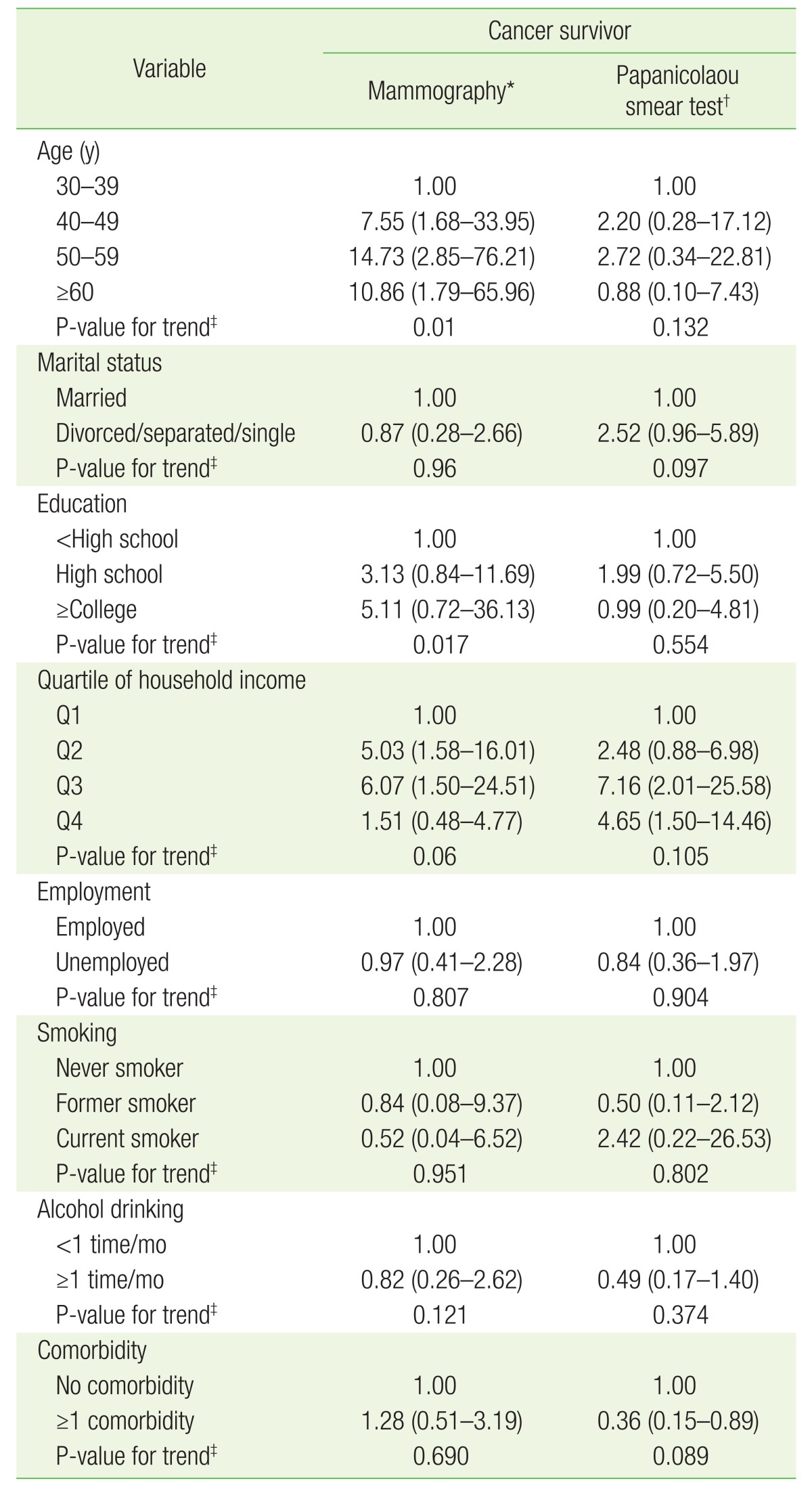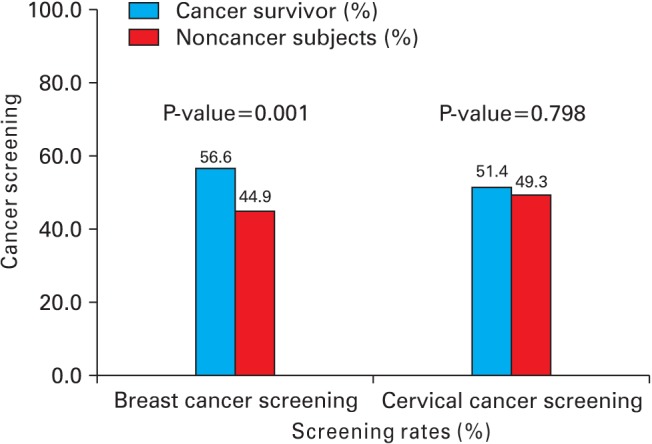2. Yabroff KR, Lawrence WF, Clauser S, Davis WW, Brown ML. Burden of illness in cancer survivors: findings from a population-based national sample. J Natl Cancer Inst 2004;96:1322-1330. PMID:
15339970.



3. Dong C, Hemminki K. Second primary neoplasms in 633,964 cancer patients in Sweden, 1958-1996. Int J Cancer 2001;93:155-161. PMID:
11410860.


4. Travis LB. The epidemiology of second primary cancers. Cancer Epidemiol Biomarkers Prev 2006;15:2020-2026. PMID:
17057028.


5. Bellizzi KM, Rowland JH, Jeffery DD, McNeel T. Health behaviors of cancer survivors: examining opportunities for cancer control intervention. J Clin Oncol 2005;23:8884-8893. PMID:
16314649.


7. Trask PC, Rabin C, Rogers ML, Whiteley J, Nash J, Frierson G, et al. Cancer screening practices among cancer survivors. Am J Prev Med 2005;28:351-356. PMID:
15831340.


8. Cho J, Guallar E, Hsu YJ, Shin DW, Lee WC. A comparison of cancer screening practices in cancer survivors and in the general population: the Korean national health and nutrition examination survey (KNHANES) 2001-2007. Cancer Causes Control 2010;21:2203-2212. PMID:
21052819.


9. Corkum M, Urquhart R, Kephart G, Hayden JA, Porter G. Breast and cervical cancer screening behaviours among colorectal cancer survivors in Nova Scotia. Curr Oncol 2014;21:e670-e677. PMID:
25302037.



10. Park SM, Park CT, Park SY, Bae DS, Nam JH, Cho CH, et al. Factors related to second cancer screening practice in disease-free cervical cancer survivors. Cancer Causes Control 2009;20:1697-1703. PMID:
19688183.



11. National Cancer Center. Cancer facts and figures 2015. Goyang: National Cancer Center; 2015.
12. Han MA, Choi KS, Park JH, Moore MA, Park EC. Midcourse evaluation of the second-term 10-year plan for cancer control in Korea. Asian Pac J Cancer Prev 2011;12:327-333. PMID:
21517281.

13. Shin DW, Kim YW, Oh JH, Kim SW, Chung KW, Lee WY, et al. Knowledge, attitudes, risk perception, and cancer screening behaviors among cancer survivors. Cancer 2011;117:3850-3859. PMID:
21319155.


14. Korea Centers for Disease Control and Prevention. The fourth Korea National Health and Nutrition Examination Survey guide book (KNHANES IV 2007-2009). Cheongju: Korea Centers for Disease Control and Prevention; 2007-2009.
15. Korea Centers for Disease Control and Prevention. The fifth Korea National Health and Nutrition Examination Survey guide book (KNHANESV 2010-2012). Cheongju: Korea Centers for Disease Control and Prevention; 2010-2012.
16. Shin DW, Baik YJ, Kim YW, Oh JH, Chung KW, Kim SW, et al. Knowledge, attitudes, and practice on second primary cancer screening among cancer survivors: a qualitative study. Patient Educ Couns 2011;85:74-78. PMID:
21036507.


17. Yang YH. A path analysis on factors influencing second primary cancer screening practices in stomach, colon, and breast cancer survivors. J Korean Acad Nurs 2014;44:139-148. PMID:
24859119.


19. Grunfeld E, Hodgson DC, Del Giudice ME, Moineddin R. Population-based longitudinal study of follow-up care for breast cancer survivors. J Oncol Pract 2010;6:174-181. PMID:
21037867.



20. Grunfeld E, Moineddin R, Gunraj N, Del Giudice ME, Hodgson DC, Kwon JS, et al. Cancer screening practices of cancer survivors: population-based, longitudinal study. Can Fam Physician 2012;58:980-986. PMID:
22972732.


21. Kwon JS, Elit L, Saskin R, Hodgson D, Grunfeld E. Secondary cancer prevention during follow-up for endometrial cancer. Obstet Gynecol 2009;113:790-795. PMID:
19305321.


22. Earle CC, Neville BA. Under use of necessary care among cancer survivors. Cancer 2004;101:1712-1719. PMID:
15386307.


23. Snyder CF, Earle CC, Herbert RJ, Neville BA, Blackford AL, Frick KD. Preventive care for colorectal cancer survivors: a 5-year longitudinal study. J Clin Oncol 2008;26:1073-1079. PMID:
18309941.


25. Suh M, Choi KS, Park B, Lee YY, Jun JK, Lee DH, et al. Trends in cancer screening rates among Korean men and women: results of the Korean National Cancer Screening Survey, 2004-2013. Cancer Res Treat 2016;48:1-10. PMID:
25943324.



26. Katz SJ, Hofer TP. Socioeconomic disparities in preventive care persist despite universal coverage: breast and cervical cancer screening in Ontario and the United States. JAMA 1994;272:530-534. PMID:
8046807.


27. Welch C, Miller CW, James NT. Sociodemographic and health-related determinants of breast and cervical cancer screening behavior, 2005. J Obstet Gynecol Neonatal Nurs 2008;37:51-57.


28. Choi KH, Heo J, Kim S, Jeon YJ, Oh M. Factors associated with breast and cervical cancer screening in Korea: data from a national community health survey. Asia Pac J Public Health 2013;25:476-486. PMID:
24151045.


29. Park JK, Park HA. Screening rates of major cancers after a cancer diagnosis in adults in Korea. Korean J Health Promot 2012;12:67-74.














